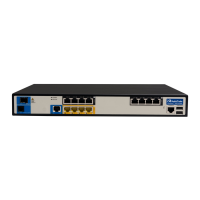Version 6.8 13 Mediant MSBR
Configuration Guide 2. IPv4
2 IPv4
IPv4 is the common and most widespread version of the Internet Protocol which is
responsible for routing traffic on the internet and private networks. IPv4 also defines the
structure and rules of IP addressing for network devices and nodes.
MSBR maintains a routing table which lists the IP addresses familiar to the device and how
to reach them in terms of next-hop. Information stored in the routing table is received from
different sources, such as local physical and logical interfaces, static routes configured by
the network administrator, and dynamic routing protocols. All of the listed items are seen as
different routing domains.
IP addresses on the MSBR are configured on interfaces, and usually are accompanied by
the subnet mask, which is used for the subnet calculation.
Each Layer-3 interface can be assigned one primary IP address, and several secondary IP
addresses. Secondary IP addresses are typically used to provide connectivity to several
subnets through a single interface, facilitating network transitions and multi-homing.
2.1 Example of Primary and Secondary IP Address
Configuration
The following is an example of primary and secondary IP address configuration.
2.1.1 Configuration
MSBR# configure data
MSBR(conf-data)# interface VLAN 1
MSBR(conf-if-VLAN 1)# ip address 192.169.12.1 255.255.255.0
MSBR(conf-if-VLAN 1)# ip address 192.169.0.1 255.255.255.0
secondary
MSBR(conf-if-VLAN 1)# no shutdown
2.1.2 Output
MSBR# show data int vlan 1
VLAN 1 is Connected.
Description: LAN switch VLAN 1
Hardware address is 00:90:8f:4a:23:43
IP address is 192.169.12.1
netmask is 255.255.255.0
State Time: 242:26:48
Time since creation: 242:27:11
Time since last counters clear : 0:00:05
mtu auto
Secondary IP address is 192.169.0.1
Secondary netmask is 255.255.255.0
DNS is configured static
DNS primary IP address is 0.0.0.0
DNS secondary IP address is 0.0.0.0

